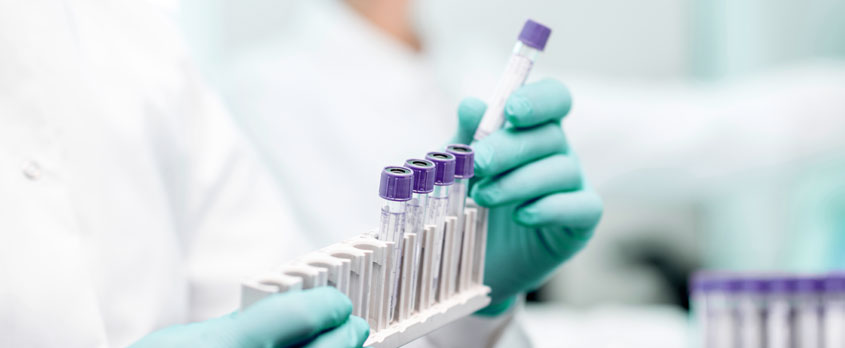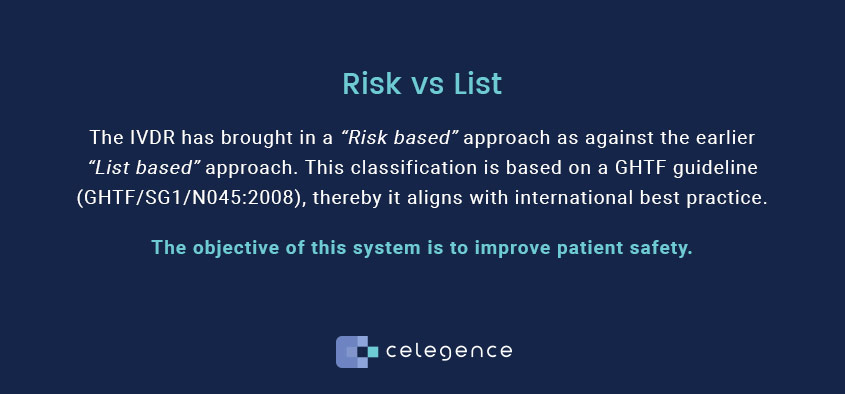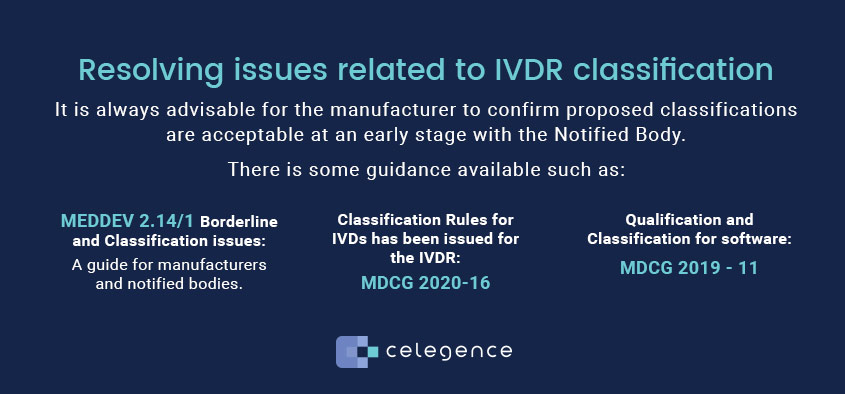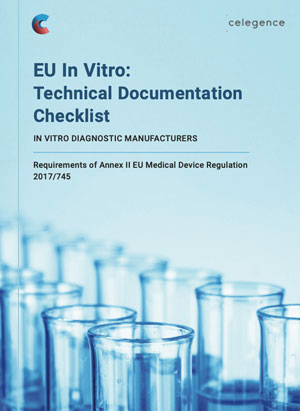
Greater Recognition of In Vitro Diagnostics (IVDs)
In vitro diagnostics (IVDs) have always been an important part of the healthcare industry. However, historically this sector has tended to be overshadowed by the medical devices sector, both in the public consciousness and in the regulatory space. The COVID-19 pandemic changed this situation, with the ubiquitous use of Lateral Flow Tests (LFT) and Polymerase Chain Reaction (PCR) tests playing a significant and visible role in the public healthcare response. During the pandemic and ever since, the industry has come into the limelight and its role has received greater recognition, both from the public and regulators.
European CE Marking Changes for IVDs
During the pandemic, the regulatory framework for European CE Marking underwent tremendous change, with significant impact on manufacturers. Following several years of development, the In Vitro Diagnostic Medical Devices Regulation (EU) 2017/746, known as the ‘IVDR’, was published in April 2017. On 26th May 2022 this regulation entered into force, after a transition period of five years. This replaced the IVD Directive (IVDD), which had been in place since 1998. One key change it introduced was the way in which devices are classified. Correct classification is the very first step in the process of regulatory compliance. Therefore, it is important that manufacturers must first understand this new system and then apply it to their own devices.
The checklist highlights all of the documentation that you will need in place for certification of your IVD device and will serve as a guide to help you achieve ongoing compliance. In conjunction with this checklist, we are also able to provide you with bespoke strategies to bring your business up to speed. We are currently working with businesses from the United States, India, and throughout Europe to ensure that they are ready for the deadline in May of 2022.
Classification under the IVD Directive: IVDD 98/79/EC
Under the IVDD, devices were classified using a “List based” approach. Two lists, (List A and List B) of categories of assays for specific medical conditions or pathogens were used to classify some products for higher levels of regulatory scrutiny, including the involvement of a Notified Body. Product classification was achieved in part by reference to these lists, leading to selection of the appropriate conformity assessment route, detailed in the Annexes of the Directive. Where not listed by assay type, IVDs for self-testing were also subject to similar conformity assessment requirements to List B products, giving four possible classifications under the IVDD:
- Annex II, List A: This list has products, Reagents, calibrators, and controls including –
- Blood grouping products (ABO system, rhesus, anti-Kell);
- Products identifying blood borne pathogens like HIV, HBV, HCV, HTLV-I/-II well as the detection of variant Creutzfeldt–Jakob Disease (vCJD). These are the highest risk products.
- Annex II, List B:
- Products for blood groups (anti-Duffy and anti-Kidd); irregular anti-erythrocytic antibodies; rubella and toxoplasmosis; phenylketonuria; cytomegalovirus or chlamydia; tumor marker PSA; determination of HLA tissue types DR, A, B; for the evaluation of the risk of trisomy 21, including software; products for self-diagnosis of blood sugar levels, including instruments.
- Products for self-testing: e.g. Pregnancy tests, (see Article 9 and Annex I, Section 7)
- General IVDs: Products not listed above are all classified as “General IVDs”. These did not require the involvement of a Notified Body for obtaining the CE mark.
Classification Under the IVD Regulation (IVDR): (EU) 2017/746
The IVDR has brought in a “Risk based” approach as against the earlier “List based approach”. This classification is based on a GHTF guideline (GHTF/SG1/N045:2008), thereby it aligns with international best practice. The objective of this system is to improve patient safety. Although IVDs do not typically have the potential to cause direct harm, as may be the case with other medical devices, they do have the potential to cause indirect harm. For instance, an erroneous false positive or false negative result may lead to incorrect diagnosis and incorrect treatment leading to harm to the patient of varying magnitudes. For example, consider the impact of an incorrect test result for COVID-19 or for HIV.
Devices are now classified into four classes- Class A, B, C, D (highest) depending on the risk of the product. Only Class A products do not require Notified Body oversight. Under the IVDR, more than 80% of the IVDs will require notified body approvals, as against the 20% IVDs under IVDD!
Therefore, before considering CE marking, it is imperative that manufacturers revisit their device’s classification under the new rules and the implications of up-classification is huge!

Table 1: IVD Risk Classes
| Class of Device | Risk | Some Examples |
|---|---|---|
| Class D | High risk to the patient and a high risk to public health | Detection of Life threatening, transmissible pathogens intended to be used for transplantation or transfusion. Egs., HIV- I/II, HBC, HCV, blood grouping |
| Class C | High risk to the patient and/or medium risk to public health | Varied products such as high risk diseases, tissue compatibility tests, sexually transmitted diseases, cancer testing, genetic testing, pre-natal testing, companion diagnostics, screening tests, some self- testing devices |
| Class B | Moderate individual patient risk and/or low public health risk | Self-testing IVD devices for pregnancy and fertility testing, detection of cholesterol, erythrocytes, leucocytes and bacteria in urine. Also controls without a quantitative or qualitative assigned value |
| Class A | Low risk to the patient and low public health risk | Specimen receptacles, Instruments and general purpose reagents, buffers or stains used for diagnosis |
Table 1: IVD risk classes.
Annex VIII of the IVDR details the classification system which comprises ten implementing rules and seven classification rules. IVD devices, accessories, software, equipment, reagents, calibrators, controls are all covered by the new system. Both these sets of rules are to be used for identifying the class of a product. A critical factor in determining a device classification is the intended purpose, therefore it is important to have this clearly documented.
MDCG has published a guidance for the classification of IVDs. Refer: Guidance on Classification Rules for in vitro Diagnostic Medical Devices under Regulation (EU) 2017/746 (MDCG 2020-16 Rev.1)
How to classify your device
It is the manufacturer’s responsibility to classify its products. The first step is to write down clearly the intended purpose of the device. This should also consider factors like indications of use, the user, their technical expertise, and also the patient group. Such a detailed intended purpose then can help identify the right class of the product. After the class of the product is identified, the conformity assessment route can be selected, based on which, the technical documentation and all other requirements can be identified and fulfilled. The risk class appears on the Declaration of Conformity. It is to be included in the Technical Documentation along with the justification, the rule and sub-rules applied.

Resolving issues related to IVDR classification
Applying the rules can sometimes lead to ambiguous situations. For instance, a PCR general purpose reagent would be Class A, but when it is used specifically for detecting HIV virus, it can be a Class D or a Class C product. When resolving such issues, it is always advisable for the manufacturer to confirm proposed classifications are acceptable at an early stage with the Notified Body. There is some guidance available such as –
- MEDDEV 2.14/1 Borderline and Classification issues – a guide for manufacturers and notified bodies.
- Classification Rules for IVDs has been issued for the IVDR: MDCG 2020-16
- Qualification and Classification for software: MDCG 2019 – 11
The checklist highlights all of the documentation that you will need in place for certification of your IVD device and will serve as a guide to help you achieve ongoing compliance. In conjunction with this checklist, we are also able to provide you with bespoke strategies to bring your business up to speed. We are currently working with businesses from the United States, India, and throughout Europe to ensure that they are ready for the deadline in May of 2022.
IVDR Reclassification Conclusions
The new classification system under the IVDR is a rule and risk-based system. Classification of devices is the first step in the compliance process since conformity assessment procedures, technical documentation is all based on classification. In fact, the scrutiny by Notified Bodies and Competent Authorities also depends on classification, with the high-risk classes having more stringent requirements. This article reviews the new classification system brought in under the EU IVDR.
The checklist highlights all of the documentation that you will need in place for certification of your IVD device and will serve as a guide to help you achieve ongoing compliance. In conjunction with this checklist, we are also able to provide you with bespoke strategies to bring your business up to speed. We are currently working with businesses from the United States, India, and throughout Europe to ensure that they are ready for the deadline in May of 2022.



